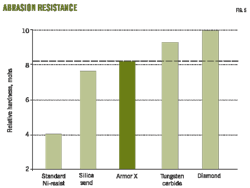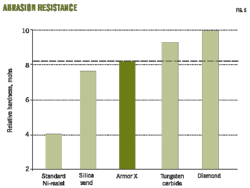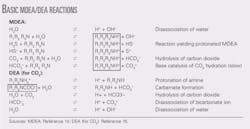David Pavel, Brian Grayson
Weatherford International Ltd.
Houston
Pore pressure and well optimization data from closed-loop circulating provide synergies for managing the production life of a well.
This concluding part in a series of four articles discusses emerging technologies and applications that further leverage the capabilities of closed-loop systems. These advances extend benefits beyond drilling safety and efficiency into the realm of completion design, production enhancement, and field development.
The three previous parts (OGJ, Dec. 6, 2010, p. 84; Jan. 3, 2011, p. 86; and Feb. 7, 2011, p. 84) covered the system fundamentals and manual and automated pressure management.
Closed-loop systems
With a closed loop of incompressible drilling fluid, the driller can detect almost immediately microfluctuations in wellbore pressure and flow. The insights gained from this data drive a scalable, modular pressure-management system that ranges from fast, accurate kick and loss detection with conventional mud and blowout preventer procedures to automated process control. These capabilities offer a capability to see and manage influxes and losses before they become well-control events and thus enhance safety and efficiency.
Aside from this, the industry only is beginning to understand and apply the full value of these real-time, downhole pressure data.
Emerging technologies leveraged by a closed-loop drilling system and combined with its inherent data-acquisition capabilities foretell a new wave of while-drilling capabilities not only to optimize drilling but also to improve completion design, enhance production and field development, and ultimately extend a simple change in the rig circulation system to benefits that affect the life of the well.
Improved prediction
Downhole pressure data acquired via a closed-loop drilling system provide actionable pressure and flow information to guide the drilling team (Fig. 1). The same information provides data points for real-time pore pressure predictions that further enhance drilling safety and efficiency.
In conjunction with the rig operator, the closed-loop system allows a direct inference of pore pressure by ramping down the rig pumps to invite a minute influx. The operator can then use this point of divergence of inflow and outflow to determine pore pressure (Fig. 1).
To make pore pressure predictions, geopressure specialists examine a wide reange of data collected while drilling. The data fall into two primary groups: quantitative and qualitative.
Quantitative data describe absolute, concrete physical information acquired by logging-while-drilling (LWD) tools such as sonic, gamma, and pressure-while-drilling (PWD) measurements.
Qualitative measurements include background gas, connection gases, the size and quantity of cuttings and shavings coming over the shakers, and drilling measurements such as torque, rate of penetration, and mud density.
Geopressure consultants use all this information to develop a predictive model of pore pressure—effectively a look ahead of the bit. The accuracy and speed of the data acquired from closed-loop instrumentation is an advantage in predrill prediction of pore pressures and a major advance in updating the predictive model in real time based on actual drilling conditions.
Typically, pore pressure estimates depend on establishing a normal compaction trend line for a particular area. The trend line is a relatively straight-forward presentation of offset data but accuracy is important. The trend line is the basis for calculating actual pore pressure and if the trend line data are inaccurate, the pore pressure prediction is incorrect.
Producing an accurate trend line is something of an art. In addition to accurate information, it requires a highly experienced person to combine all the quantitative and qualitative elements to make a correct prediction of the pore pressure regime.
Better, faster data
The workflow for developing and refining pore pressure predictions has three stages. Predrill studies examine offset wells and historical experience to compare predictions with actual pressure points and other data to predict pore pressure for a particular area.
On site geopressure services provide 24-hr well monitoring while drilling in order to modify the predrill plan with actual well data being collected from instrumentation and what is coming across the shale shakers. The process entails a real-time comparison of what is happening vs. the theoretical expectation.
These on site predictions also benefit from wellsite information transfer standard markup language (WITSML) enabled data transfer that facilitates real-time participation by remote experts.
For a recent project in Trinidad, Weatherford pore-pressure experts on multiple rigs collaborated with a colleague in Port of Spain who provided an additional source of interpretation.
An important distinction between conventional real-time pore prediction and managed pressure drilling (MPD) based operations is data quality. Conventional predictions rely on data acquired with a PWD instrument near the bit. But PWD data do not always provide accurate data points on downhole pressure anomalies.
A closed-loop system allows for detection of bottomhole anomalies at the surface within seconds and in increments of only a few degrees of pressure.
Consistency can also be an issue. A PWD instrument is unable to acquire data when the mud pumps are off, leaving a potential blind spot at a critical stage of pressure management. Conversely, a key characteristic of an MPD system is that maintaining backpressure while making a connection provides an excellent environment for monitoring wellbore pressure. Integrating the two complementary data sets and using them in unison provides a more comprehensive pore-pressure analysis.
Once the well is drilled, the third step in the process is a post-drill analysis. The study examines the acquired data to determine absolute pressure values for the well. Those figures when compared to the on site prediction are used to update the model. This becomes a continual updating process through the repetition of predrill, drilling, and post-drill workflow phases.
The integration of real-time pressure data with this process of refining the pressure profile further reduces uncertainty and enables drillers to better control mud weights, define casing points, and improve overall drilling efficiency and safety.
The goal is to reduce uncertainty, not only at the current depth but ahead of the bit.
Integrating geomechanical input
An important factor in the success of this pore-pressure prediction capability is its contribution to the larger picture of wellbore stability through integration with geomechanical data. Joining these disciplines to complete a fuller picture is important because borehole stability is not always a function of pore pressure.
Often the geomechanics and tectonics regime causes the wellbore to collapse in an event that is unrelated to the pore pressure. A complete understanding of what is being dictated by the tectonic and geomechanical stresses and what is related to pore pressure is important for maintaining wellbore stability.
Weatherford approaches this integration with cross-discipline experts using proprietary software and specialized design tools. The design software analyzes the risks of wellbore instability, lost circulation, fracturing, sand production, and fault, fracture or bedding plane slippage. An important aspect of this analysis is the software's ability to incorporate accurate pore-pressure data acquired during drilling operations.
The inclusion of MPD methodologies and closed-loop technology in this integrated wellbore stability analysis provides a proactive means of managing pore pressure with significant gains in safety and efficiency. High-resolution, closed-loop measurements acquired in real time enable on site geopressure analysis with much more accurate information that ultimately results in better predictive models.
For instance, the system's coriolis meters (which measure mass flow past a fixed point per unit of time) are downstream of the choke manifold and have greater accuracy than conventional paddle or rolling flow meters—typically between a gallon and half a barrel, depending on circumstances.
The accuracy and immediacy of these data provide a high degree of insight into what is happening downhole and improve the options for response with more flexibility than simply weighting up the mud system.
Well, field optimization
The addition of new technology aimed at drilling optimization and reservoir characterization objectives further leverages the real-time pressure measurements obtained from a closed-loop system.
The addition of a field-deployable X-ray fluorescence device enables a complete elemental break down of the rock cuttings. This data can provide insights into the rock's geomechanical properties such as brittleness.
The inclusion of gas chromatography instrumentation in an MPD system provides the ability not only to see a gas flux but also to characterize its composition. This capability enhances completion and production decisions as well as contributes to drilling safety and efficiency. The assessment takes place in real time while circulating the well.
During drilling, surface quantitative gas detection is an important gas data point for kick detection and pressure management that has implications for improved efficiency. Previously available gas analysis on pressurized closed-loop circulation systems relied on conventional trap technology located behind the mud-gas separator where there is considerable alteration of the gas signature and the data have minimum correlation to actual gas volumes at the surface. Combined with inconsistencies in gas extraction methods and efficiencies, this has meant that one could derive little information from surface gas monitoring in these circumstances.
With a patented semipermeable membrane gas-extraction process located directly behind the choke manifold and ahead of the mud gas separator, the sampling point becomes part of the enclosed system, which improves the removal of any potential surface gas loss.
A series of North Sea wells illustrated the capabilities of the closed-loop system for identifying gas stringers vs. kick events without interrupting drilling operations. Over the course of the drilling program, increased confidence in the data resulted in more aggressive procedures to drill through the stringers.
Addition of the gas chromatograph to the MPD system further enhanced the understanding of well behavior and conflicting data derived from traditional mud logging. While mud log data were inaccurate and initially led to confusion regarding the gas events, the chromatograph detected connection gases with much greater precision and accuracy.
As a result, the operation experienced improved connection times and a reduced percolation time required before drilling ahead after each connection, saving the operator a considerable amount of time. In total, the combined system cut about 75 days from the drilling operation when compared to the previous well (Fig. 2).
This instance illustrates the inaccuracy of standard mud logging and the insights achievable with high-fidelity data. Additional experience in the same drilling program led to increased reliance on the combined gas chromatograph and closed-loop data over the conventional logging system.
Fluid characterization
In addition to identifying gas in the fluid system, the gas chromatograph also provides a very important capability for characterizing the composition of gas from the reservoir. While still developing as a component of the MPD with a closed-loop system, this technology points to a future of increasingly sophisticated capabilities while drilling. These capabilities extend far beyond drilling safety and efficiency to affect completion, production, and life of well considerations.
Gas characterization while drilling indicates whether the formation is producing a dry gas, a condensate, medium-gravity oil, or heavy-gravity oil. This directly addresses the objective of drilling the well in the first place—the production value—through more accurate, informed design of completions and production infrastructure.
It also has an immediate impact on reducing expenses. For example, in a recent non-MPD deepwater Gulf of Mexico well, a very tight pore pressure/fracture gradient window made deployment of wireline tools problematic. The ability to analyze the fluid type at the surface eliminated the need to acquire downhole fluid samples via wireline.
The overall savings was about $3 million including the rig spread rate, nonproductive time, and service expenses.
In addition to characterization and concentration of reservoir gases, another related technology being developed by Weatherford is isotope logging while drilling. This advance isotopic analyses of mud gases can reveal if a gas is bacterial or thermogenic in origin and also can characterize the thermal maturity of the rocks that generated a thermogenic gas.
One can imagine numerous simple practical applications for such information. For example, if a gas is entirely bacterial in origin, then the likelihood of a downdip oil leg is small. If a gas is thermogenic or is mixed thermogenic and biogenic, however, then it may or may not have an associated oil leg.
Future
As these technologies and synergies evolve, the benefits of closed-loop circulating take on new importance as a watershed improvement over conventional drilling operations. From its fundamental drilling safety and efficiency capabilities, the closed-loop system is evolving rapidly as it opens the door for advancements in optimizing the well and exploiting the reservoir.
What began as a simple change in the fluids return system now promises new production opportunities over the life of the well.
More Oil & Gas Journal Current Issue Articles
More Oil & Gas Journal Archives Issue Articles
View Oil and Gas Articles on PennEnergy.com




